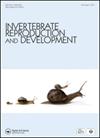Profiling of methyl farnesoate in relation to female reproductive cycle in the freshwater crab, Travancoriana schirnerae Bott, 1969 (Crustacea: Gecarcinucidae)
IF 0.8
4区 生物学
Q4 REPRODUCTIVE BIOLOGY
引用次数: 3
Abstract
ABSTRACT The sesquiterpenoid, methyl farnesoate, produced by the mandibular organ of decapod crustaceans has a variety of functions including the regulation of moulting, reproduction, morphogenesis, behaviour and osmoregulation. This study used gas chromatography and mass spectrometric analysis to measure the haemolymph concentration of methyl farnesoate during various developmental stages of the ovary of the edible freshwater crab Travancoriana schirnerae. The results revealed exceptionally low methyl farnesoate titres in the haemolymph during the avitellogenic and previtellogenic periods (5.7 ± 0.7 and 12.8 ± 1.3 ng/mL, respectively), reaching a peak in the early vitellogenic period (91.8 ± 3.8 ng/mL), followed by a significant fall during the middle and late vitellogenic stages (32.1 ± 2.3 and 22.1 ± 1.6 ng/mL, respectively). The progressive increase and decrease in the haemolymph titre of methyl farnesoate in accordance with the stages of the ovarian cycle clearly indicated the role of this hormone in growth and maturation of the ovary. Furthermore, administration of methyl farnesoate can be exploited as an alternate method to the traditional eyestalk ablation practised for inducing ovarian maturation and spawning.淡水蟹(tranancorana schirnerae Bott)雌性生殖周期与法诺酸甲酯的关系分析(甲壳纲:蟹科)
十足甲壳类动物下颌骨器官产生倍半萜类化合物法尼酸甲酯,具有多种功能,包括调节换羽、繁殖、形态发生、行为和渗透调节。本研究采用气相色谱和质谱分析方法测定了可食用淡水蟹(Travancoriana schirnerae)卵巢不同发育阶段血淋巴中法尼酸甲酯的浓度。结果显示,在卵黄形成和卵黄形成前期,血淋巴中法脂酸甲酯滴度异常低(分别为5.7±0.7和12.8±1.3 ng/mL),在卵黄形成早期达到峰值(91.8±3.8 ng/mL),随后在卵黄形成中后期显著下降(分别为32.1±2.3和22.1±1.6 ng/mL)。法尼索酸甲酯血淋巴滴度随卵巢周期阶段的逐渐升高和降低,清楚地表明了这种激素在卵巢生长和成熟中的作用。此外,法尼索酸甲酯的施用可以作为传统的眼柄消融的一种替代方法,用于诱导卵巢成熟和产卵。
本文章由计算机程序翻译,如有差异,请以英文原文为准。
求助全文
约1分钟内获得全文
求助全文
来源期刊
CiteScore
1.90
自引率
0.00%
发文量
21
审稿时长
>12 weeks
期刊介绍:
Invertebrate Reproduction & Development ( IRD) presents original research on the reproductive and developmental biology of the Invertebrata, both embryonic and postembryonic. IRD welcomes papers reporting significant results obtained using new techniques. Encouraged topic areas include: aquaculture, physiology, biochemistry, functional morphology, phylogeny, behavioural and regulatory mechanisms, including genetic, endocrine and molecular studies. Papers containing qualitative descriptions of reproductive cycles and gametogenesis will not be considered. IRD is published in association with the International Society of Invertebrate Reproduction and Development.

 求助内容:
求助内容: 应助结果提醒方式:
应助结果提醒方式:


